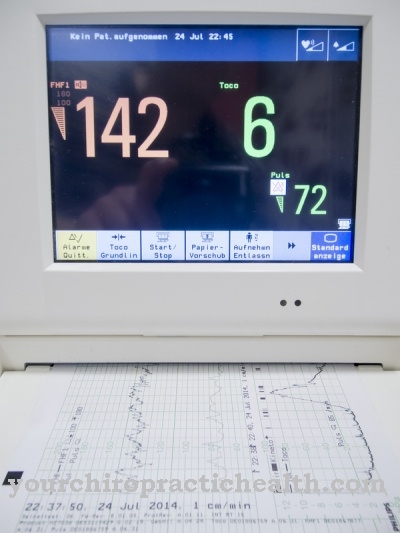Anyone who has smoked for a long time and has tried at least once to quit smoking knows how difficult it is to persevere. Withdrawal symptoms are unpleasant and can shake your mind again. A Nicotine replacement therapy can temporarily help with weaning.
What is nicotine replacement therapy?

Many smokers find it difficult to quit of their own accord because the nicotine addiction is too strong, especially if you have smoked for a long time. Therefore, in nicotine replacement therapy, nicotine is supplied to the body in dosed form in order to alleviate physical withdrawal symptoms.
The substitute products also release nicotine, but in a smaller form and more slowly than cigarettes. In addition, nicotine replacement products do not contain tar, carbon monoxide or other carcinogenic substances found in cigarettes. Such nicotine replacement products are offered as nicotine chewing gums, patches, lozenges, inhalers (e-cigarettes) or nasal sprays.
Function, effect & goals
Nicotine is partly responsible for the addiction of smokers to tobacco products, but on its own it is not as addictive as animal experiments and studies of human drug use show.
However, in conjunction with other substances contained in a cigarette, it increases the risk of addiction. Just a few days of moderate cigarette consumption can be enough to create physical dependence. That is why nicotine replacement products only contain nicotine. There are several types of nicotine replacement products:
Nicotine patches regularly deliver a certain dose of nicotine to the body via a membrane or adhesive layer so that the nicotine level remains constant. They are available in different strengths, depending on how many cigarettes a smoker has previously smoked in a day. Nicotine patches are particularly suitable for those wishing to quit with moderate to severe nicotine dependence and a relatively high cigarette consumption (at least 10 to over 40 cigarettes), which is evenly distributed throughout the day.
Nicotine chewing gum should be chewed slowly and carefully until the nicotine starts to work. If enough nicotine has been absorbed, the chewing gum should remain in the cheek pouch. Nicotine chewing gum is especially suitable for smokers with a low to medium cigarette consumption (up to 15 cigarettes per day). They are also helpful when smoking is mainly linked to certain situations, e.g. B. in stressful situations, in company, in a restaurant, in front of the television, etc.). In these critical moments, nicotine chewing gum is a sensible replacement for the cigarette.
Nicotine lozenges release nicotine for 10 to 30 minutes, which works through the lining of the mouth. The tablets are particularly suitable for medium to heavy cigarette consumption, which is not evenly distributed throughout the day. They are usually recommended as 2 mg tablets, but heavy smokers are better off using 4 mg tablets.
Nasal sprays are quickly supplied to the body through the nasal mucosa and are relatively high-dose. Therefore, they are primarily suitable for smokers with a strong desire and who consume at least 30 cigarettes per day.
With a nicotine inhaler (e-cigarette) you inhale nicotine through a mouthpiece like a cigarette. In addition to nicotine, the inhaler also contains flavorings such as menthol. One cartridge contains 10 or 15 mg of nicotine.
With the exception of the nicotine nasal spray, all nicotine replacement preparations can be bought over the counter in pharmacies.
You can find your medication here
➔ Medicines for smoking cessationRisks, side effects & dangers
Smokers wishing to quit should be aware that nicotine replacement preparations can support cessation on a physical level, but are not intended to be a substitute for cigarette smoking. Nicotine replacement therapy is only suitable for bridging the initial period with the terrible physical withdrawal symptoms. First and foremost, smoking cessation is about changing harmful behavior.
Studies have shown that replacement therapy is effective as an intermediate step towards finally giving up cigarettes. When used correctly, nicotine chewing gum etc. have only minor side effects such as dizziness, headaches, slight stomach / intestinal problems, and rarely palpitations or chest pain. In people with sensitive skin, nicotine patches can cause skin reddening and itching, and chewing gum and tablets can irritate the mucous membranes. However, since smoking causes more damage to the body over the long term, especially with high cigarette consumption, temporary nicotine replacement therapy is the lesser evil, especially since - as studies show - it can effectively promote cigarette smoking.
Deciding what type of substitute to consider depends on what type of smoker someone is. For heavy smokers, nicotine patches are best, which can be supplemented with chewing gum or tablets in critical situations if necessary. Nicotine replacement therapy should not last longer than 12 weeks if possible, so as not to exchange cigarette addiction for dependence on nicotine replacement products. In order to improve stamina, smoking cessation courses or programs are also useful in order to practice behavioral measures for a smoke-free life during the replacement therapy.
Anyone who takes medication must take into account during replacement therapy that nicotine may cause medication to be excreted more quickly and have a worse effect during this time. Nicotine replacement therapy cannot be recommended to pregnant women because the potential health risks for the child have not yet been researched. You are better off with conventional smoking cessation.













.jpg)

.jpg)
.jpg)











.jpg)